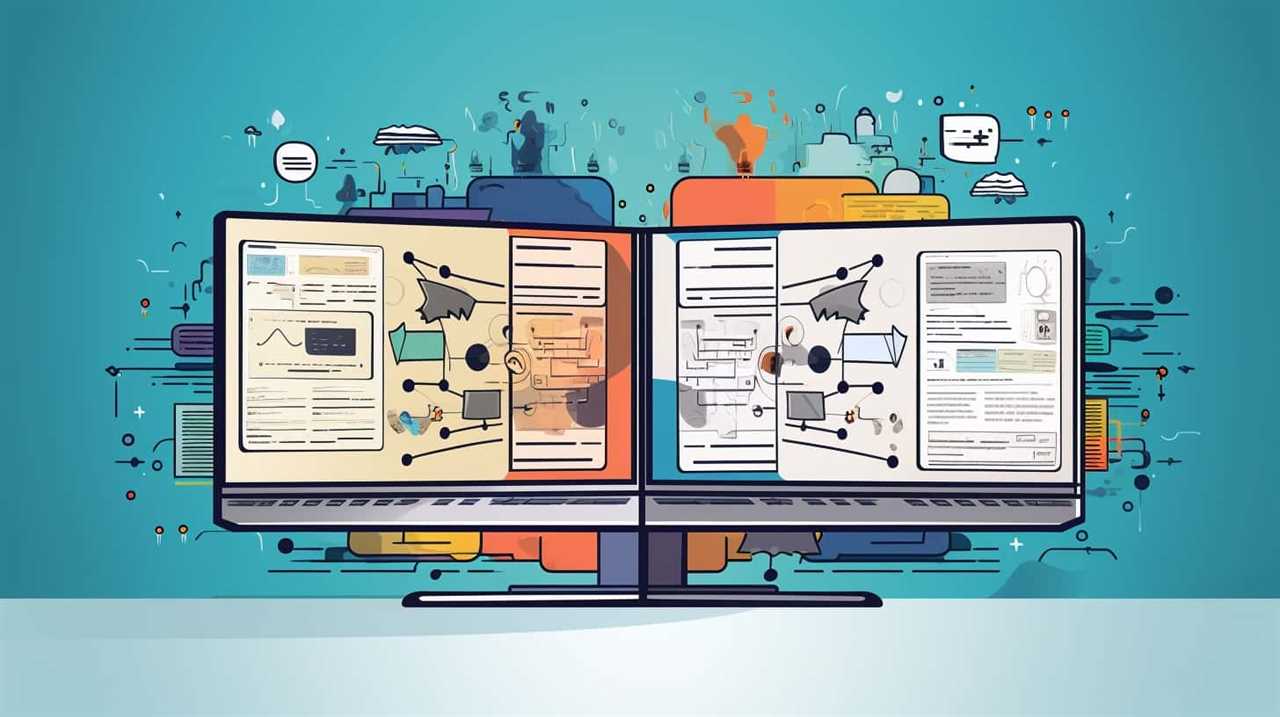Discover how to captivate your audience and improve engagement through our 15 innovative strategies for an unmatched user experience.
We understand the power of engaging and informative content, and we’re here to share our secrets.
From understanding your audience to optimizing page loading speed, we’ve got you covered.
Craft compelling headlines and create valuable content that will leave your users craving more.

With our help, you’ll continuously improve and update your content, ensuring a user experience that sets you apart.
Get ready to revolutionize your content game and leave your users liberated and satisfied.
Key Takeaways
- Understanding and segmenting the audience to tailor content to their needs
- Optimizing content for search engines and user engagement through keyword research and crafting compelling headlines
- Enhancing user experience through visual elements, mobile optimization, and user-friendly navigation
- Prioritizing readability, scannability, and easy access to information by using clear and concise writing, providing relevant links, and organizing content effectively
Understand Your Audience
We prioritize understanding our audience to create a superior user experience through content. Audience segmentation and user behavior analysis play a crucial role in achieving this goal.
By segmenting our audience, we can identify specific groups with unique characteristics and preferences. This allows us to tailor our content to their needs, ensuring it resonates and engages with them on a deeper level.

User behavior analysis helps us gain insights into how our audience interacts with our content, enabling us to optimize their experience. By understanding their browsing patterns, interests, and preferences, we can deliver personalized and relevant content that meets their expectations.
This user-focused approach not only enhances the user experience but also empowers our audience, giving them the freedom to explore and consume content that truly matters to them.
Conduct Keyword Research
To further optimize our content for superior user experience, conducting keyword research is essential. By understanding user intent and incorporating relevant long tail keywords, we can create content that resonates with our audience and meets their needs.
Here are three key reasons why keyword research is crucial:

- Understanding user intent: Keyword research helps us gain insights into what our target audience is searching for. By identifying their intent, we can tailor our content to provide the information or solutions they’re seeking.
- Discovering long tail keywords: Long tail keywords are specific phrases that have lower search volume but higher conversion rates. By incorporating these keywords into our content, we can attract more qualified traffic and increase the chances of conversion.
- Improving SEO and visibility: Keyword research allows us to optimize our content for search engines. By targeting relevant keywords, we can improve our search rankings and increase our visibility to potential users.
Craft Compelling Headlines
Crafting compelling headlines is essential for attracting users to your content.
A catchy headline can make a significant impact by grabbing their attention and piquing their curiosity.
Attracting Users With Headlines
How can we create compelling headlines that attract users to our content?
Crafting enticing headlines is crucial to improve readability and increase engagement. Here are three strategies to help you create irresistible headlines:

- Use numbers: Incorporating numbers in your headlines instantly grabs attention and promises a clear structure. For example, ‘5 Tips to Boost Your Productivity’ or ’10 Ways to Improve Your Health.’
- Pose a question: Asking a thought-provoking question in your headline stimulates curiosity and encourages users to click. For instance, ‘Are You Making These Common Mistakes in Your Marketing Strategy?’ or ‘Want to Know the Secret to Financial Freedom?’
- Include power words: Utilize strong and persuasive language that creates a sense of urgency or excitement. Words like ‘ultimate,’ ‘essential,’ or ‘exclusive’ can make your headlines more compelling.
Crafting captivating headlines is just the beginning. Now let’s explore the impact of these catchy headlines on user engagement and conversion rates.
Impact of Catchy Headlines
After crafting compelling headlines that attract users to our content, we can now explore the impact of these catchy headlines on user engagement and conversion rates. Writing effective headlines is crucial for capturing the attention of our audience and enticing them to click through and read our content. One important aspect to consider is the length of the headline. Studies have shown that headline length can greatly affect user engagement. Too short and it may not provide enough information, but too long and it may lose the user’s interest. Finding the right balance is key. To illustrate this point, let’s take a look at the following table showcasing the impact of headline length on user engagement and conversion rates:
| Headline Length | User Engagement | Conversion Rates |
|---|---|---|
| Short | Low | Medium |
| Medium | High | High |
| Long | Medium | Low |
As we can see, headlines of medium length tend to have the highest user engagement and conversion rates. This is because they provide enough information to capture interest while still maintaining brevity. Therefore, when crafting our headlines, we must consider the importance of headline length to ensure that we are maximizing user engagement and conversion rates.
Create Valuable and Informative Content
When it comes to creating valuable and informative content, there are a few key techniques that we can employ to engage our users and keep them coming back for more.

First, we need to ensure that our content is user-centric, meaning it addresses their needs, interests, and pain points. By understanding our users and tailoring our content to their preferences, we can provide them with valuable information that’s relevant and useful.
Additionally, we can employ engaging content techniques such as storytelling, visuals, and interactive elements to make our content more captivating and memorable.
Engaging Content Techniques
To create valuable and informative content, we engage users through various techniques. Here are three effective strategies for engaging content:
- Engaging Storytelling: We use captivating narratives to connect with users on an emotional level. By telling stories that resonate with their experiences and aspirations, we can create a deeper connection and keep them engaged.
- Interactive Experiences: We provide interactive elements such as quizzes, polls, and games to actively involve users in the content. This not only enhances their experience but also allows them to acquire knowledge and information in a more engaging and enjoyable way.
- Visual Content: We incorporate visually appealing elements like images, infographics, and videos to make the content more engaging and easy to digest. Visuals help to break up text and convey information more effectively, keeping users interested and enhancing their understanding.
User-Centric Content Creation
How can we create valuable and informative content that prioritizes the needs and preferences of our users?

The key lies in adopting a user-centric approach to content creation. By understanding our audience and their requirements, we can tailor our content to provide maximum value and engagement.
A well-defined content strategy is crucial in this process. It involves conducting thorough research to identify the interests, pain points, and preferences of our users. By creating content that addresses these aspects, we can ensure that our users find our content valuable and informative.
Additionally, we must continuously analyze and evaluate user engagement metrics to refine our content strategy and make it even more user-focused. Remember, the key to superior user experience lies in delivering content that truly resonates with our audience.
Use a Clear and Concise Writing Style
Using a clear and concise writing style enhances user experience through content. When it comes to creating engaging and user-focused content, it’s important to keep the writing style concise and easy to understand. Here are three tips to improve your writing style and make it more effective:

- Eliminate unnecessary words and phrases: Get rid of any fluff or excessive details that don’t add value to your content.
- Use active voice: Active voice not only makes your writing more direct and engaging but also helps convey your message more effectively.
- Break down complex ideas: Simplify complex concepts by using clear and simple language, making it easier for users to comprehend.
Incorporate Visual Elements
We can enhance user experience through content by incorporating visual elements that engage and captivate our audience. Visual storytelling is a powerful tool that allows us to convey complex information in a compelling and easily understandable way. By using visuals such as images, videos, and illustrations, we can create a more immersive and interactive experience for our users.
Infographic design is another effective way to incorporate visual elements into our content. Infographics combine text, images, and data to present information in a visually appealing and easily digestible format. They’re particularly useful for presenting statistics, comparisons, and step-by-step processes.
Optimize for Mobile Devices
To optimize for mobile devices, let’s consider the importance of responsive design and its impact on user experience. Mobile optimization is crucial in today’s digital landscape, where users are increasingly accessing content on their smartphones and tablets.
Here are three key reasons why mobile optimization is essential for a user-friendly design:

- Improved accessibility: Mobile-optimized websites make it easier for users to navigate and interact with content on smaller screens, ensuring a seamless experience across devices.
- Faster load times: Mobile optimization helps to minimize loading times, reducing user frustration and increasing engagement.
- Enhanced visibility: With the growing number of mobile users, optimizing for mobile devices improves your website’s visibility in search engine results, driving more traffic and potential conversions.
Utilize Multimedia Content
Let’s talk about how to enhance user engagement and boost satisfaction through the use of multimedia content.
By incorporating images, videos, and audio into our content, we can create a more immersive and interactive experience for our users. This not only captures their attention but also helps to convey information in a more engaging and memorable way.
Enhancing Engagement With Multimedia
One key strategy for enhancing engagement with multimedia content is to incorporate a variety of interactive elements throughout the user experience. This approach allows users to actively participate and immerse themselves in the content, maximizing interactivity and creating a more engaging and memorable experience.
Here are three ways to enhance engagement through multimedia:

- Interactive storytelling: By using interactive elements such as quizzes, games, and interactive videos, you can involve users in the storytelling process. This not only captures their attention but also encourages them to explore the content further.
- Gamification: Incorporating gamification elements like leaderboards, badges, and challenges can make the multimedia experience more enjoyable and motivating. It adds a sense of competition and achievement, keeping users engaged and coming back for more.
- Personalization: Tailoring the multimedia content based on user preferences and behaviors can significantly enhance engagement. By providing personalized recommendations, interactive menus, and customizable features, you can create a more personalized and meaningful experience for each user.
Incorporating these strategies won’t only enhance engagement with multimedia content but also provide users with a liberating and enjoyable user experience.
Boosting User Satisfaction
We can enhance user satisfaction by leveraging multimedia content through various strategies. By incorporating multimedia elements such as images, videos, and audio into our content, we create a more engaging and immersive experience for our users. This not only captures their attention but also allows them to better understand and connect with the information being presented. To measure user satisfaction, we can track metrics such as time spent on page, click-through rates, and user feedback. Additionally, conducting surveys and interviews can provide valuable insights into how users perceive and interact with our multimedia content. By continuously improving user experience and measuring user satisfaction, we can ensure that our content meets the needs and expectations of our audience, leading to higher levels of user satisfaction and engagement.
| Strategies for Boosting User Satisfaction | Benefits | Examples |
|---|---|---|
| Incorporating high-quality images | Enhances visual appeal and comprehension | Using professional photographs or illustrations that relate to the topic |
| Creating informative and engaging videos | Increases user engagement and understanding | Producing tutorial videos or product demonstrations |
| Adding audio elements | Enhances the overall user experience | Including background music, voiceovers, or sound effects in multimedia presentations |
Implement User-Friendly Navigation
To optimize user experience, our content strategy focuses on the implementation of intuitive and seamless navigation. We understand that users desire liberation when navigating through a website or app, and we aim to provide just that.
Here are three key strategies we employ to improve navigation and enhance user flow:

- Clear and Consistent Menu Structure: We ensure that the menu is logically organized and easy to understand. Users should be able to find what they need quickly and effortlessly.
- Search Functionality: We incorporate a robust search feature that allows users to find specific content or products with ease. The search results should be relevant and accurate.
- Intuitive Design: We prioritize simplicity and clarity in our design. Buttons, links, and icons should be placed strategically and labeled clearly to guide users through the interface seamlessly.
Prioritize Readability and Scannability
With an emphasis on clear and concise content, our focus now shifts to prioritizing readability and scannability for an enhanced user experience.
In order to improve legibility and enhance scannability, it’s crucial to present information in a way that’s easily digestible and accessible to our audience. This means using clear headings, subheadings, and bullet points to help users quickly find the information they need.
Additionally, using a legible font and appropriate font size ensures that the content is easily readable, especially on different devices and screen sizes.
Provide Easy Access to Relevant Information
To ensure an uninterrupted flow of information, it’s essential to seamlessly transition from prioritizing readability and scannability to providing easy access to relevant information. Easy navigation and relevant content go hand in hand to create a superior user experience.

Here are three strategies to achieve this:
- Clear and intuitive menu structure: Organize your content in a logical and hierarchical manner, making it easy for users to find what they’re looking for. Utilize drop-down menus, breadcrumbs, and search functionality to enhance navigation.
- Effective search functionality: Implement a robust search feature that allows users to quickly find specific information. Incorporate filters and sorting options to refine search results and make it easier for users to locate relevant content.
- Contextual linking: Embed hyperlinks within your content to connect related topics and provide additional information. This helps users navigate seamlessly between different pages and find the information they need without any hassle.
Include Internal and External Links
Including internal and external links enhances the user experience by providing additional resources and connecting relevant information seamlessly. By incorporating these links into your content, you can improve SEO and increase website traffic. Internal links are hyperlinks that direct users to other pages within your website, while external links lead users to external websites. Both types of links serve different purposes but are equally important in enhancing the overall user experience. Internal links help users navigate your website and discover related content, while external links provide additional information and sources that support your content. To illustrate the importance of internal and external links, consider the following table:
| Type of Link | Purpose | Benefits |
|---|---|---|
| Internal | Easy navigation and discovery | Improves SEO and keeps users engaged |
| External | Additional information and sources | Enhances credibility and provides value |
Including internal and external links not only improves the user experience but also boosts your website’s visibility and authority. So, make sure to include relevant and valuable links in your content to provide an enhanced user experience and drive more traffic to your website.
Optimize Page Loading Speed
When it comes to optimizing page loading speed, there are three key points to consider.

First, we need to minimize file sizes by compressing images and using efficient coding practices.
Second, utilizing caching techniques can greatly improve loading times by storing frequently accessed data.
Finally, optimizing server response time is crucial in ensuring a seamless user experience.
Minimize File Sizes
We can improve user experience by reducing file sizes to enhance page loading speed. When it comes to optimizing web content, minimizing file sizes is crucial. Here are three strategies to achieve this:

- Reduce image sizes: Large image files can significantly slow down page loading speed. To address this, use image compression techniques to reduce file size without compromising image quality. Consider using image optimization tools or plugins to automatically compress images on your website.
- Compress video files: Videos are often large files that can be a major culprit in slowing down page loading speed. Compressing videos can help reduce their file size while maintaining good quality. Use video compression software or services to optimize your videos for web playback.
- Minify code: Another way to minimize file sizes is by minifying your code. Remove unnecessary spaces, line breaks, and comments from your HTML, CSS, and JavaScript files. This reduces file size and improves loading speed.
Use Caching Techniques
To optimize page loading speed, we can enhance user experience through the use of caching techniques. By implementing caching, we can improve performance and increase efficiency, providing a faster and smoother browsing experience for our users. Caching involves storing frequently accessed data in temporary storage, allowing for quicker retrieval and reducing the need to fetch information from the server repeatedly. This not only speeds up page loading times but also minimizes the strain on server resources, resulting in a more efficient and reliable website. To illustrate the benefits of caching, consider the following table:
| Without Caching | With Caching |
|---|---|
| Slow page loads | Faster page loads |
| High server load | Reduced server load |
| Frustrated users | Satisfied users |
| Decreased efficiency | Increased efficiency |
Optimize Server Response Time
As we continue our exploration into enhancing user experience through content, let’s delve into optimizing server response time to further improve page loading speed. Minimizing latency and improving server performance are crucial steps in ensuring a seamless browsing experience for our users. Here are three strategies to achieve this:
- Utilize caching techniques: By storing frequently accessed data closer to the user, we can reduce the time it takes to retrieve information from the server, resulting in faster page loading speeds.
- Implement content delivery networks (CDNs): CDNs distribute website content across multiple servers located in different geographic regions. This ensures that users can access content from a server that’s physically closer to them, minimizing latency and improving overall performance.
- Optimize code and database queries: Streamlining code and optimizing database queries can significantly improve server response time. This involves reducing unnecessary code, minimizing database calls, and optimizing queries for better efficiency.
Encourage User Engagement and Feedback
User engagement and feedback play a crucial role in optimizing the overall user experience. Encouraging user participation and gathering user insights not only allows us to understand their needs and preferences but also empowers them to actively participate in shaping the content and experience they desire.
By actively seeking feedback through surveys, polls, and comment sections, we’re able to gain valuable insights into what our users want and make informed decisions to improve their experience. This two-way communication fosters a sense of community and trust, making users feel heard and valued.

Additionally, user engagement and feedback enable us to identify and rectify any issues or pain points that may be hindering the user experience.
Continuously Improve and Update Your Content
One key strategy for superior user experience through content is to regularly improve and update our content. By continuously refining our content, we can improve engagement and increase conversions.
Here are three ways to achieve this:
- Conduct regular content audits: Review your existing content to identify areas for improvement. Look for outdated information, broken links, or any content that’s no longer relevant. Updating and optimizing your content will ensure that it remains valuable and helpful to your users.
- Stay up to date with industry trends: Keep a pulse on the latest developments in your industry and incorporate them into your content. This will demonstrate your expertise and keep your audience engaged with fresh and relevant information.
- Listen to user feedback: Pay attention to what your users are saying and incorporate their suggestions into your content updates. This will show that you value their input and are committed to providing them with the best possible experience.
Frequently Asked Questions
How Can I Improve Page Loading Speed for My Website?
To improve page loading speed for our website, we optimize website speed by reducing image sizes, minifying CSS and JavaScript files, and leveraging browser caching. This ensures a faster, more efficient user experience.

What Are Some Effective Strategies for Encouraging User Engagement and Feedback?
Want to enhance user engagement and feedback? Conduct user surveys to understand their needs and preferences. Incorporate gamification elements like badges and rewards to make the experience enjoyable. Let’s explore effective strategies!
What Are Some Best Practices for Continuously Improving and Updating Website Content?
To continuously improve and update website content, we prioritize content refresh and SEO optimization. By regularly refreshing our content and optimizing it for search engines, we ensure a superior user experience and keep our audience engaged.
How Can I Optimize My Content for Mobile Devices?
To optimize our content for mobile devices, we focus on mobile content optimization and responsive design. By ensuring our website adapts seamlessly to different screen sizes, we provide a superior user experience for all.
What Are Some Key Elements to Consider When Implementing User-Friendly Navigation on a Website?
When implementing user-friendly navigation on a website, we consider the website structure and user flow. It’s important to create a seamless experience that allows users to easily find what they’re looking for, enhancing their overall satisfaction.

Conclusion
In conclusion, by implementing these strategies, we can create a superior user experience through our content.
Some may argue that it requires too much time and effort, but picture this: a website where users effortlessly navigate through valuable information, engage with the content, and find exactly what they’re looking for.
It’s a seamless and satisfying experience that keeps them coming back for more.
So let’s invest in creating user-focused content that leaves a lasting impression.











